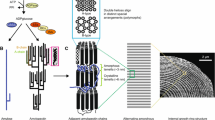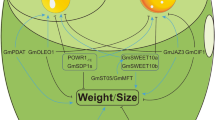Abstract
Key message
The cloning and characterization of a novel C2H2 zinc finger protein that affects rice eating and cooking quality by regulating amylose content and amylopectin chain-length distribution in rice.
Abstract
One of the major objectives in rice breeding aims to increase simultaneously yield and grain quality especially eating and cooking quality (ECQ). Controlling amylose content (AC) and amylopectin chain-length distribution (ACLD) in rice is a major strategy for improving rice ECQ. Previous studies show that some starch synthesis-related genes (SSRGs) are required for normal AC and ACLD, but its underlying regulating network is still unclear. Here, we report the cloning and characterization of a novel C2H2 zinc finger protein TL1 (Translucent endosperm 1) that positively regulates amylose synthesis in rice grains. Loss of TL1 function reduced apparent amylose content (AAC), total starch, gel consistency, and gelatinisation temperature, whereas increased viscosity, total lipid, and ratio of amylopectin A chains with degree of polymerization (DP) 6–12 to B1 chains with DP 13–24, resulting in an enhanced grain ECQ. The improved ECQ was accompanied by altered expression patterns of several tested SSRGs in tl1 mutant grains. Furthermore, knockout of TL1 in the high-yielding rice variety JiaHua NO.1 reduced AAC without obvious side effects on major agronomic traits. These findings expand our understanding of the regulating networks of grain starch metabolism and provide new insights into how rice ECQ quality can be improved via genetic approach.







Similar content being viewed by others
Data availability
All data supporting the findings of this study are available within the paper and within its supplementary data published online.
Abbreviations
- AAC:
-
Apparent amylose content
- AC:
-
Amylose content
- ACLD:
-
Amylopectin chain-length distribution
- DAF:
-
Days after flowering
- DB:
-
Degree of branching
- dCAPs:
-
Derived cleaved amplified polymorphic sequence
- DP:
-
Degree of polymerization
- ECQ:
-
Eating and cooking quality
- GBSS 1:
-
Granule-bound starch synthase 1
- GC:
-
Gel consistency
- GT:
-
Gelatinization temperature
- MAS:
-
Marker-assisted selection
- SEM:
-
Scanning electron microscopy
- SSRGs:
-
Starch synthesis-related genes
References
Baysal C, He WS, Drapal M, Villorbina G, Medina V, Capell T, Khush GS, Zhu CF, Fraser PD, Christou P (2020) Inactivation of rice starch branching enzyme IIb triggers broad and unexpected changes in metabolism by transcriptional reprogramming. Proc Natl Acad Sci USA 117:26503–26512. https://doi.org/10.1073/pnas.2014860117
Bello BK, Hou YX, Zhao J et al (2019) NF-YB1-YC12-bHLH144 complex directly activates Wx to regulate grain quality in rice (Oryza sativa L.). Plant Biotechnol J 17:1222–1235. https://doi.org/10.1111/pbi.13048
Han YY, Zhou HY, Xu LA, Liu XY, Fan SX, Cao JS (2018) The zinc-finger transcription factor BcMF20 and its orthologs in Cruciferae which are required for pollen development. Biochem Biophys Res Commun 503:998–1003. https://doi.org/10.1016/j.bbrc.2018.06.108
Holm J, Björck I, Drews A, Asp MD (1986) A Rapid Method for the Analysis of Starch 38(7):224–226. https://doi.org/10.1002/star.19860380704
Huang XY, Chao DY, Gao JP, Zhu MZ, Shi M, Lin HX (2009) A previously unknown zinc finger protein, DST, regulates drought and salt tolerance in rice via stomatal aperture control. Genes Dev 23:1805–1817. https://doi.org/10.1101/gad.1812409
Huang LC, Li QF, Zhang CQ, Chu R, Gu ZW, Tan HY, Zhao DS, Fan XL, Liu QQ (2020) Creating novel Wx alleles with fine-tuned amylose levels and improved grain quality in rice by promoter editing using CRISPR/Cas9 system. Plant Biotechnol J 18:2164–2166. https://doi.org/10.1111/pbi.13391
Huang XR, Su F, Huang S, Mei FT, Niu XM, Ma CL, Zhang H, Zhu XG, Zhu JK, Zhang JS (2021a) Novel Wx alleles generated by base editing for improvement of rice grain quality. J Integr Plant Biol 63:1632–1638. https://doi.org/10.1111/jipb.13098
Huang LC, Gu ZW, Chen ZZ et al (2021b) Improving rice eating and cooking quality by coordinated expression of the major starch synthesis-related genes, SSII and Wx, in endosperm. Plant Mol Biol 106:419–432. https://doi.org/10.1007/s11103-021-01162-8
Igarashi H, Ito H, Shimada T, Kang DJ, Hamada S (2021) A novel rice dull gene, LowAC1, encodes an RNA recognition motif protein affecting Waxy(b) pre-mRNA splicing. Plant Physiol Biochem 162:100–109. https://doi.org/10.1016/j.plaphy.2021.02.035
Isshiki M, Matsuda Y, Takasaki A, Wong HL, Satoh H, Shimamoto K (2008) Du3, a mRNA cap-binding protein gene, regulates amylose content in Japonica rice seeds. Plant Biotechnol 25:483–487. https://doi.org/10.1016/j.fm.2004.01.015
Kang HG, Park S, Matsuoka M, An G (2005) White-core endosperm floury endosperm-4 in rice is generated by knockout mutations in the C-type pyruvate orthophosphate dikinase gene (OsPPDKB). Plant J 42:901–911. https://doi.org/10.1111/j.1365-313X.2005.02423.x
Li H, Prakash S, Nicholson TM, Fitzgerald MA, Gilbert RG (2016) Instrumental measurement of cooked rice texture by dynamic rheological testing and its relation to the fine structure of rice starch. Carbohyd Polym 146:253–263. https://doi.org/10.1016/j.carbpol.2016.03.045
Li QF, Huang LC, Chu R, Li J, Jiang MY, Zhang CQ, Fan Xl YuHX, Gu MH, Liu QQ (2018) Down-regulation of SSSII-2 gene expression results in novel low-amylose rice with soft, transparent grains. J Agric Food Chem 66:9750–9760. https://doi.org/10.1021/acs.jafc.8b02913
Li C, Wu A, Yu W, Hu Y, Li E, Zhang C, Liu QQ (2020) Parameterizing starch chain-length distributions for structure-property relations. Carbohyd Polym 241:116390. https://doi.org/10.1016/j.carbpol.2020.116390
Liu LL, Ma XD, Liu SJ et al (2009) Identification and characterization of a novel Waxy allele from a Yunnan rice landrace. Plant Mol Biol 71:609–626. https://doi.org/10.1007/s11103-009-9544-4
Lyu T, Cao J (2018) Cys(2)/His(2) Zinc-finger proteins in transcriptional regulation of flower development. Int J Mol Sci 19:2589. https://doi.org/10.3390/ijms19092589
Mikami I, Aikawa M, Hirano HY, Sano YS (1999) Altered tissue-specific expression at the Wx gene of the opaque mutants in rice. Euphytica 105:91–97. https://doi.org/10.1023/a:1003457209225
Nishi A, Nakamura Y, Tanaka N, Satoh H (2001) Biochemical and genetic analysis of the effects of amylose-extender mutation in rice endosperm. Plant Physiol 127:459–472. https://doi.org/10.1104/pp.010127
Prigge MJ, Wagner DR (2001) The Arabidopsis serrate gene encodes a zinc-finger protein required for normal shoot development. Plant Cell 13:1263–1279. https://doi.org/10.1105/TPC.010095
Sato H, Suzuki Y, Sakai M, Imbe I (2002) Molecular characterization of Wx-mq, a novel mutant gene for low-amylose content in endosperm of rice (Oryza sativa L.). Breed Sci 52:131–135. https://doi.org/10.1270/jsbbs.52.131
Satoh H, Nishi A, Yamashita K, Takemoto Y, Tanaka Y, Hosaka Y, Sakurai A, Fujita N, Nakamura Y (2003) Starch-branching enzyme deficient mutation specifically affects the structure and properties of starch in rice endosperm. Plant Physiol 133:1111–1121. https://doi.org/10.1104/pp.103.021527
Satoh H, Shibahara K, Tokunaga T et al (2008) Mutation of the plastidial alpha-glucan phosphorylase gene in rice affects the synthesis and structure of starch in the endosperm. Plant Cell 20:1833–1849. https://doi.org/10.1105/tpc.107.054007
Tan YF, Li JX, Yu SB,·Xing YZ,·Xu CG, Zhang Q. (1999) The three important traits for cook and eating quality of rice grains are controlled by a single locus in an elite rice hybrid, Shanyou 63. Theor Appl Genet 99:642–648. https://doi.org/10.1007/s001220051279
Tian ZX, Qian Q, Liu Q et al (2009) Allelic diversities in rice starch biosynthesis lead to a diverse array of rice eating and cooking qualities. Proc Natl Acad Sci USA 106:21760–21765. https://doi.org/10.1073/pnas.0912396106
Yu L, Fan J, Yan C, Xu C (2018) Starch deficiency enhances lipid biosynthesis and turnover in leaves. Plant Physiol 178:118–129. https://doi.org/10.1104/pp.18.00539
Xiao H, Tang J, Li Y et al (2009) STAMENLESS 1, encoding a single C2H2 zinc finger protein, regulates floral organ identity in rice. Plant J 59:789–801. https://doi.org/10.1111/j.1365-313X.2009.03913.x
Xu X, Vanhercke T, Shrestha P et al (2019) Upregulated lipid biosynthesis at the expense of starch production in potato (Solanum tuberosum) vegetative tissues via simultaneous downregulation of adp-glucose pyrophosphorylase and sugar dependent1 expressions. Front Plant Sci 10:1444. https://doi.org/10.3389/fpls.2019.01444
Xu Y, Lin Q, Li X et al (2021) Fine-tuning the amylose content of rice by precise base editing of the Wx gene. Plant Biotechnol J 19:11–13. https://doi.org/10.1111/pbi.13433
Wang ZY, Zheng FQ, Shen GZ et al (1995) The amylose content in rice endosperm is related to the post-transcriptional regulation of the waxy gene. Plant J 7(4):613–622. https://doi.org/10.1046/j.1365-313X.1995.7040613.x
Wang JC, Xu H, Zhu Y, Liu QQ, Cai XL (2013) OsbZIP58, a basic leucine zipper transcription factor, regulates starch biosynthesis in rice endosperm. J Exp Bot 64:3453–3466. https://doi.org/10.1093/jxb/ert187
Zeng DL, Yan MXW, H, Liu, XF, Qian Q, Li JY. (2007) Du1, encoding a novel Prp1 protein, regulates starch biosynthesis through affecting the splicing of Wxb pre-mRNAs in rice (Oryza sativa L.). Plant Mol Biol 65:501–509. https://doi.org/10.1007/s11103-007-9186-3
Zeng DL, Tian ZX, Rao YC et al (2017) Rational design of high-yield and superior-quality rice. Nature Plants 3:17031. https://doi.org/10.1038/nplants.2017.31
Zeng D, Liu T, Ma X et al (2020) Quantitative regulation of Waxy expression by CRISPR/Cas9-based promoter and 5’UTR-intron editing improves grain quality in rice. Plant Biotechnol J 18:2385–2387. https://doi.org/10.1111/pbi.13427
Zhang CQ, Chen SJ, Ren XY et al (2017) Molecular structure and physicochemical properties of starches from rice with different amylose contents resulting from modification of OsGBSSI activity. J Agric Food Chem 65(10):2222–2232. https://doi.org/10.1021/acs.jafc.6b05448
Zhang CQ, Zhu JH, Chen SJ et al (2019) Wx (lv), the ancestral allele of rice waxy gene. Mol Plants 12:1157–1166. https://doi.org/10.1016/j.molp.2019.05.011
Zhang CQ, Yang Y, Chen SJ et al (2021) A rare Waxy allele coordinately improves rice eating and cooking quality and grain transparency. J Integr Plant Biol 63(5):889–901. https://doi.org/10.1111/jipb.13010
Zhao GC, Xie MX, Yu FY, Hu DM, Zhang T, Li JY (2017a) Development of a new fragrant and good eating quality rice cultivar with stripe virus disease resistance by molecular marker-assisted gene pyramiding. Indian J Genet Plant Breed 77:221. https://doi.org/10.5958/0975-6906.2017.00029.3
Zhao GC, Xie MX, Wang YC, Li JY (2017b) Molecular mechanisms underlying gamma-aminobutyric acid (GABA) accumulation in giant embryo rice seeds. J Agric Food Chem 65:4883–4889. https://doi.org/10.1021/acs.jafc.7b00013
Zhou W, Yang J, Hong Y, Liu G, Zheng J, Gu Z, Zhang P (2015) Impact of amylose content on starch physicochemical properties in transgenic sweet potato. Carbohyd Polym 122:417–427. https://doi.org/10.1016/j.carbpol.2014.11.003
Zhuang H, Wang HL, Zhang T et al (2020) NONSTOP GLUMES1 encodes a C2H2 zinc finger protein that regulates spikelet development in rice. Plant Cell 32:392–413. https://doi.org/10.1105/tpc.19.00682
Acknowledgements
This work was supported by the Shanghai Science and Technology Commission under Grant (19391900500), Shanghai Engineering Research Center of Plant Germplasm Resources (17DZ2252700), and a grant from the Science and Technology Commission of Shanghai Municipality (18DZ2260500).
Funding
The funding was provided by Shanghai Science and Technology Commission (Grant No. 19391900500), Shanghai Engineering Technology Research Center (Grant No. 17DZ2252700), Science and Technology Commission of Shanghai Municipality (Grant No. 18DZ2260500).
Author information
Authors and Affiliations
Contributions
GC and JY designed the experiments. SF, SP and TW performed the experiments. GC and CJ analyzed the data. GC wrote the manuscript. GC and JX modified the manuscript.
Corresponding authors
Ethics declarations
Conflict of interest
The authors declare that there are no conflicts of interest.
Additional information
Communicated by Takuji Sasaki.
Publisher's Note
Springer Nature remains neutral with regard to jurisdictional claims in published maps and institutional affiliations.
Supplementary Information
Below is the link to the electronic supplementary material.
Rights and permissions
Springer Nature or its licensor holds exclusive rights to this article under a publishing agreement with the author(s) or other rightsholder(s); author self-archiving of the accepted manuscript version of this article is solely governed by the terms of such publishing agreement and applicable law.
About this article
Cite this article
Zhao, G., Xie, S., Zong, S. et al. Mutation of TL1, encoding a novel C2H2 zinc finger protein, improves grains eating and cooking quality in rice. Theor Appl Genet 135, 3531–3543 (2022). https://doi.org/10.1007/s00122-022-04198-6
Received:
Accepted:
Published:
Issue Date:
DOI: https://doi.org/10.1007/s00122-022-04198-6




